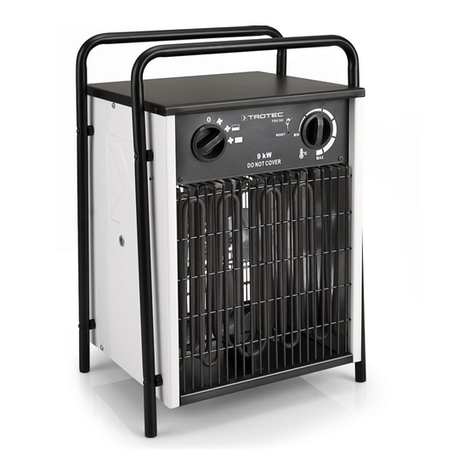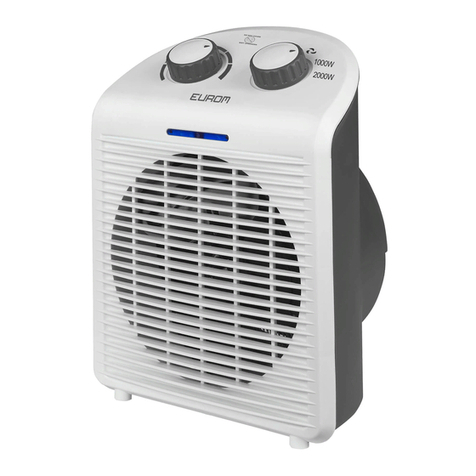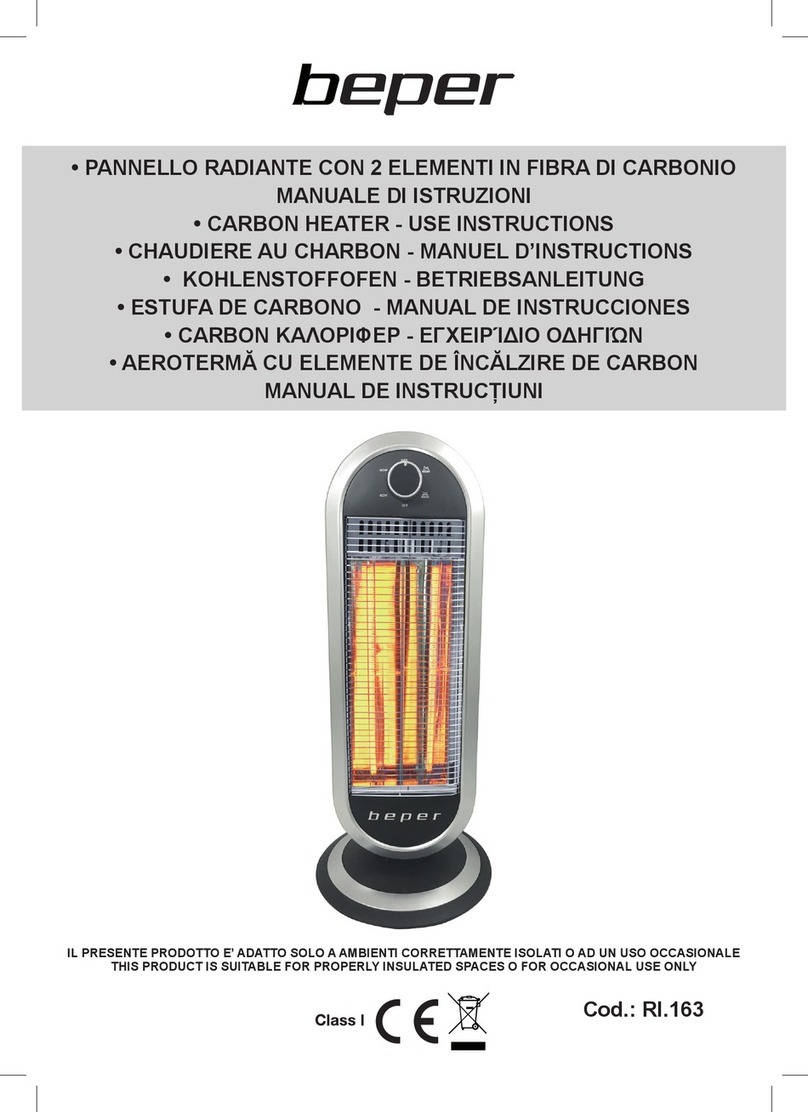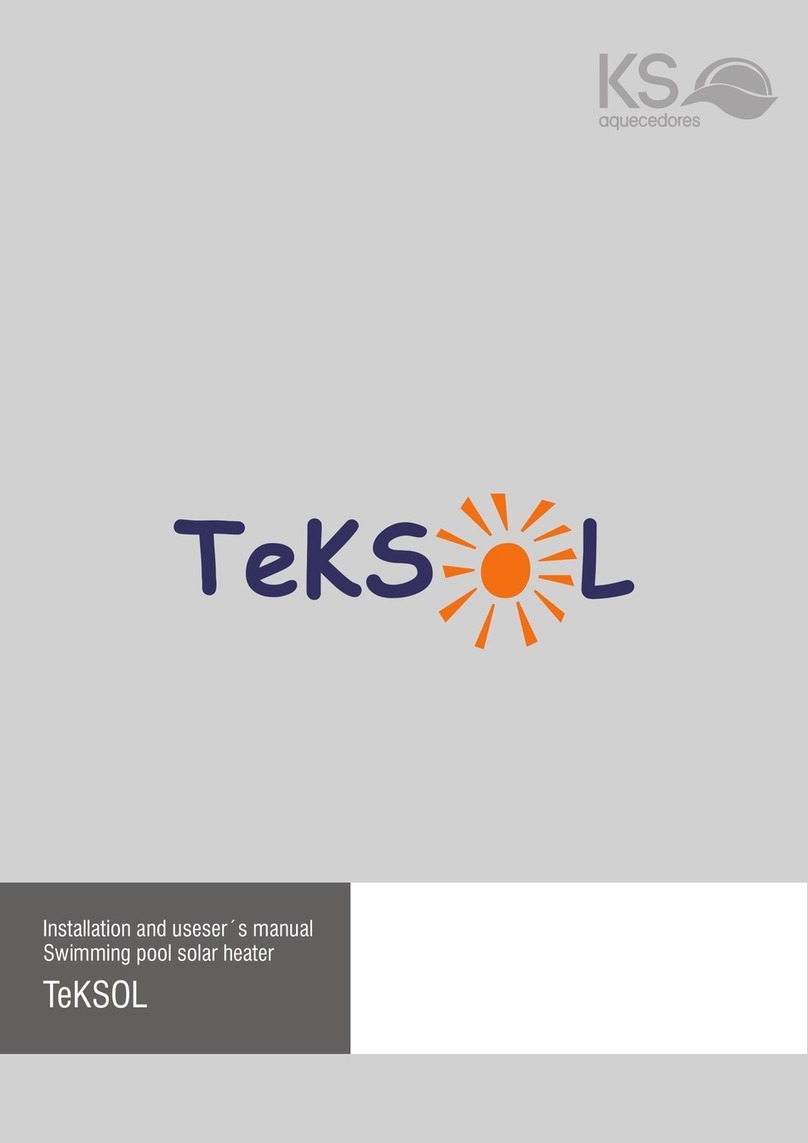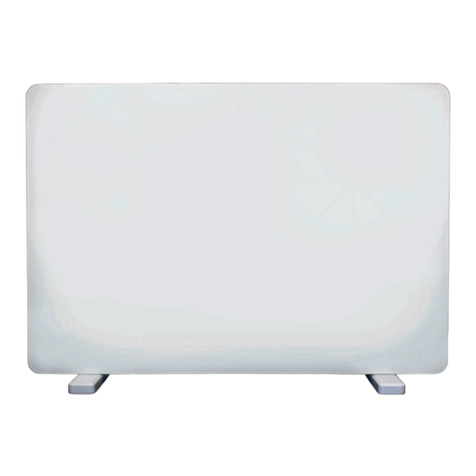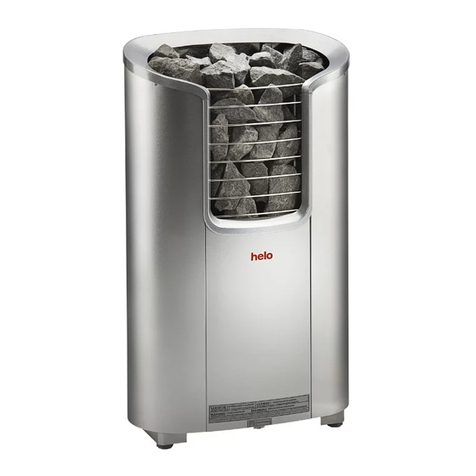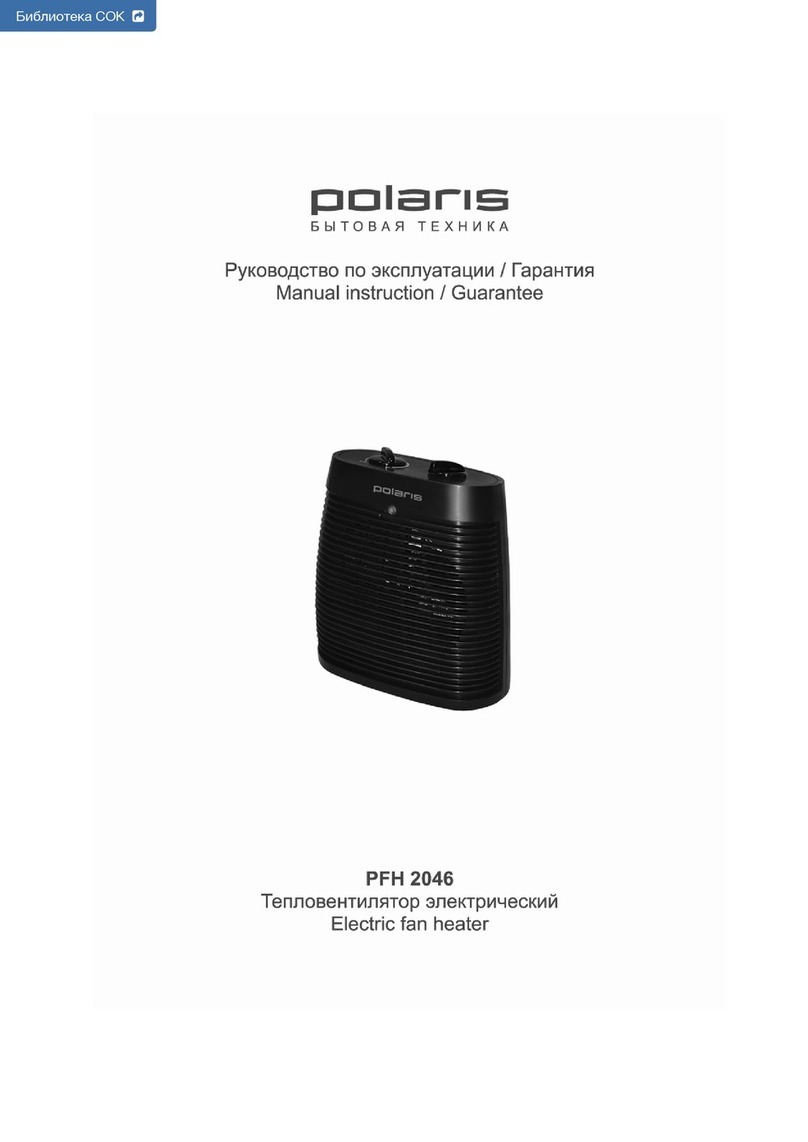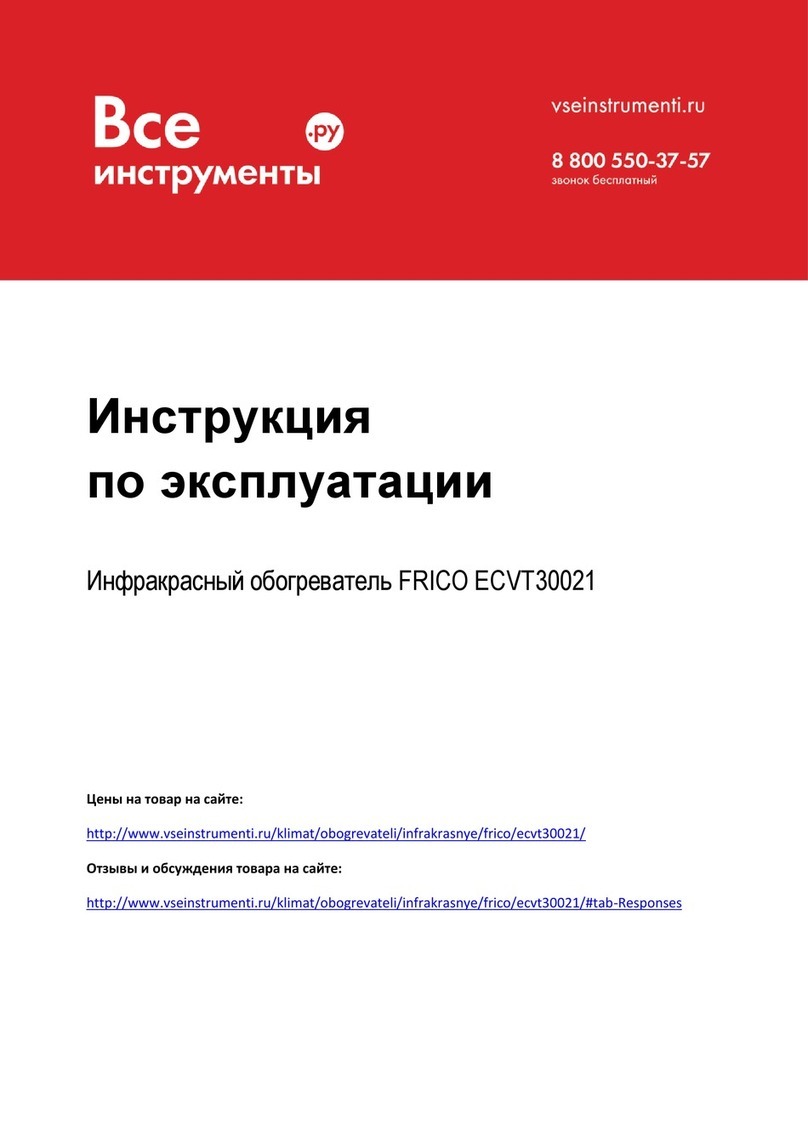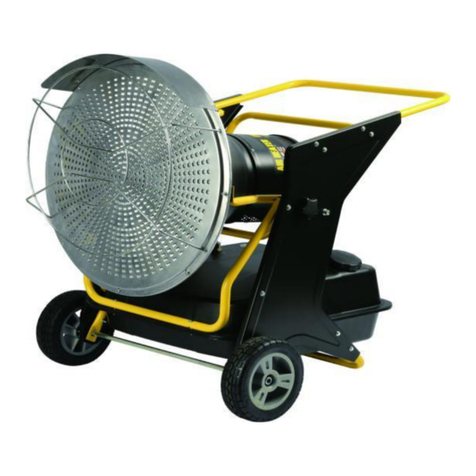Mestek NXIM-2 User manual

09/17
NXIM-2
J30-09590
Unit No. Serial No.
ATTENTION: READ THIS MANUAL AND ALL LABELS ATTACHED TO THE UNIT CAREFULLY BEFORE ATTEMPTING
TO INSTALL, OPERATE OR SERVICE THESE UNITS! CHECK UNIT DATA PLATE FOR TYPE OF GAS AND
ELECTRICAL SPECIFICATIONS AND MAKE CERTAIN THAT THESE AGREE WITH THOSE AT THE POINT OF
INSTALLATION. RECORD THE UNIT MODEL AND SERIAL No. (s) IN THE SPACE PROVIDED. RETAIN FOR FUTURE
REFERENCE.
FOR YOUR SAFETY
The use and storage of gasoline or other ammable vapors and liquids in open containers in
the vicinity of this appliance is hazardous.
FOR YOUR SAFETY
If you smell gas:
1. Open windows.
2. Don't touch electrical switches.
3. Extinguish any open ame.
4. Immediately contact your gas supplier.
APPROVED FOR USE IN CALIFORNIA
INSTALLER'S RESPONSIBILITY
Installer Please Note: This equipment has been test fired and inspected. It has been
shipped free from defects from our factory. However, shipment and installation problems
such as loose wires, leaks, or loose fasteners may occur. It is the installer's responsibility to
inspect and correct any problem that may be found.
RECEIVING INSTRUCTIONS
Inspect shipment immediately when
received to determine if any damage
has occurred to the unit during
shipment. After the unit has been
uncrated, check for any visible
damage to the unit. If any damage is
found, the consignee should sign the
bill of lading indicating such damage
and immediately le claim for damage
with the transportation company.
APPROVED FOR USE IN CALIFORNIA
Install, operate, and maintain unit in accordance with the manufacturer's
instructions to avoid exposure to fuel substances, or substances from incomplete
combustion, which can cause death or serious illness. The state of California
has determined that these substances may cause cancer, birth defects, or other
reproductive harm.
Improper installation, adjustment, alteration, service, or maintenance
can cause property damage, injury, or death. Read the installation, operating, and
maintenance instruction thoroughly before installing or servicing this equipment.
INSTALLATION INSTRUCTIONS AND PARTS IDENTIFICATION
HIGH EFFICIENCY GAS-FIRED PROPELLER UNIT HEATERS
260 NORTH ELM ST., WESTFIELD, MA 01085
TEL: (413) 564-5540 FAX: (413) 562-5311
www.mestek.com

2
TABLE OF CONTENTS
DESCRIPTION............................................................. 2
GENERAL SAFETY INFORMATION............................ 3
Installation Codes....................................................... 3
Special Precautions.................................................... 3
SPECIFICATIONS........................................................ 4
Performance & Dimensional Data ...........................4-5
INSTALLATION ............................................................ 6
Locating Units............................................................. 6
Air for Combustion ...................................................... 6
Clearances .................................................................6
Suspension of Units.................................................7-8
INSTALLATION - GAS PIPING .................................... 9
Pipe Sizing..................................................................9
Pipe Installation ........................................................ 10
INSTALLATION - CONDENSATE PIPING ................. 10
ELECTRICAL CONNECTIONS.................................. 11
Thermostat Wiring and Location............................... 11
Unit Wiring Diagrams...........................................12-14
VENTING - GENERAL GUIDELINES ........................ 15
Vent Termination Clearances.................................... 15
STANDARD COMBUSTION – HORIZONTALLY
VENTED (CAT. IV)...................................................... 16
STANDARD COMBUSTION –
VERTICALLY VENTED (CAT. IV) ............................... 17
SEPARATED COMBUSTION –
TWO PIPE VENTING............................................18-19
SEPARATED COMBUSTION –
CONCENTRIC VENTING........................................... 20
Horizontal Sidewall Mounting ..............................20-22
Vertical Roof Mounting ............................................. 22
GAS CONVERSION..............................................23-25
OPERATION .............................................................. 26
Explanation of Controls .......................................26-30
Start-Up .................................................................... 30
Shut Down................................................................ 30
GAS INPUT RATE ..................................................... 31
High Altitude Deration............................................... 31
MODBUS CONFIGURATION..................................... 31
PNEUMATIC TUBING SCHEMATIC .......................... 32
UNIT TROUBLESHOOTING GUIDE.....................33-34
LED TROUBLESHOOTING GUIDE........................... 35
MAINTENANCE ......................................................... 36
WARRANTY ...............................................................37
IDENTIFICATION OF PARTS................................38-39
Replacement Parts................................................... 39
APPENDIX A – MODBUS REGISTERS................40-41
UNIT NUMBER DESCRIPTION................................. 42
START-UP AND INSPECTION SHEET...................... 43
NOTICE: It is the equipment owner’s responsibility to provide any scaffolding or other apparatus required
to perform emergency service or annual/periodic maintenance to this equipment.
DESCRIPTION
The High Efciency Gas-Fired Unit Heaters are factory
assembled, power vented, low static pressure type
propeller fan unit heaters designed to be suspended within
the space to be heated. THESE HEATERS ARE NOT
TO BE CONNECTED TO DUCTWORK. The designs are
certied by ETL as providing a minimum of 96% thermal
efciency, and approved for use in California. Do not alter
these units in any way. If you have any questions after
reading this manual, contact the manufacturer.
The following terms are used throughout this manual,
in addition to the ETL requirements to bring attention
to the presence of potential hazards, or to important
information concerning the product:
Indicates an imminently hazardous
situation which, if not avoided, will result in death,
serious injury, or substantial property damage.
Indicates an imminently hazard-ous
situation which, if not avoided, could result in death,
serious injury, or substantial property damage.
Indicates an imminently hazardous
situation which, if not avoided, may result in minor
injury or property damage.
NOTICE: Used to notify of special instructions on
installation, operation, or maintenance which are
important to equipment but not related to personal injury.
Figure 1 - High Efciency Gas-Fired Propeller Unit Heater
See IDENTIFICATION OF PARTS, Figures 25 through 29

3
GENERAL SAFETY INFORMATION
Failure to comply with the general
safety information may result in extensive
property damage, severe personal injury, or
death.
This product must be install be
a licensed plumber or gas tter when installed
within the Commonwealth of Massachusetts.
Installation must be made in accordance with local
codes, or in absence of local codes, with the latest
edition of the ANSI Standard Z223.1 (N.F.P.A. No. 54)
National Fuel Gas Code. All of the ANSI and NFPA
Standards referred to in these installation instructions are
those that were applicable at the time the design of this
appliance was certied. The ANSI Standards are available
from CSA Information Services, 1-800- 463-6727. The
NFPA Standards are available from the National Fire
Protection Association, Batterymarch Park, Quincy,
MA 02269. These unit heaters are designed for use in
airplane hangars when installed in accordance with ANSI/
NFPA No. 409, and in public garages when installed in
accordance with NFPA No. 88A and NFPA No.88B.
If installed in Canada, the installation must conform with
local building codes, or in the absence of local building
codes, with CSA-B149.1 “Installation Codes for Natural
Gas Burning Appliances and Equipment” or CSA-B149.2
“Installation Codes for Propane Gas Burning Appliances
and Equipment.” These unit heaters have been designed
and certied to comply with CSA 2.6. Also see sections
on installation in AIRCRAFT HANGARS and PUBLIC
GARAGES.
Do not alter the unit heater in
any way or damage to the unit and/or severe
personal injury or death may occur!
Disconnect all power and gas
supplies before installing or servicing the heater.
If the power disconnect is out of sight, lock
it in the open position and tag it to prevent
unexpected application of power. Failure to do
so could result in fatal electric shock, or severe
personal injury.
Ensure that all power sources conform
to the requirements of the unit heater, or damage to
the unit will result!
Follow installation instructions CAREFULLY to avoid
creating unsafe conditions. All wiring should be done
and checked by a qualified electrician, using copper
wire only. All gas connections should be made and leak-
tested by a suitably qualied individual, per instructions
in this manual. Also follow procedures listed on GAS
EQUIPMENT START-UP AND INSPECTION SHEET
located in this manual.
Use only the fuel for which the heater is designed (see
rating plate). Using LP gas in a heater that requires
natural gas, or vice versa, will create risk of gas leaks,
carbon monoxide poisoning, and explosion.
Do not attempt to convert the
heater for use with a fuel other than the one
intended unless using a factory provided
conversion kit. Such conversion is dangerous,
as it will create the risks previously listed.
Make certain that the power source conforms to the
electrical requirements of the heater.
Do not depend upon a thermostat
or other switch as sole means of disconnecting
power when installing or servicing heater.
Always disconnect power at main circuit breaker
as described above. Failure to do so could result
in fatal electric shock.
Special attention must be given to any grounding
information pertaining to this heater. To prevent the
risk of electrocution, the heater must be securely and
adequately grounded. This should be accomplished by
connecting a ground conductor between the service
panel and the heater. To ensure a proper ground,
the grounding means must be tested by a qualified
electrician.
Do not insert fingers or foreign objects into heater or
its air moving device. Do not block or tamper with the
heater in any manner while in operation, or just after it
has been turned off, as some parts may be hot enough
to cause injury.
This heater is intended for general heating applications
ONLY. It must NOT be used in potentially dangerous
locations such as ammable, explosive, chemical-laden,
or wet atmospheres.
Do not attach ductwork to this product or use it as a
makeup air heater. Such usage voids the warranty and
will create unsafe operation.
In cases in which property damage may result from
malfunction of the heater, a back-up system or
temperature sensitive alarm should be used.
The open end of gas piping systems
being purged shall not discharge into areas where
there are sources of ignition or into conned spaces
UNLESS precautions are taken as follows: (1) by
ventilation of the space, (2) control of the purging
rate, (3) elimination of all hazardous conditions. All
precautions must be taken to perform this operation
in a safe manner!
Unless otherwise specied, the following conversions
may be used for calculating SI unit measurements:
1 foot = 0.305 m
1 inch = 25.4 mm
1 gallon = 3.785 L
1 pound = 0.453 kg
1 psig = 6.894 kPa
1 cubic foot = 0.028m3
1000 BTU/cu. ft. = 37.5 MJ/m3
1000 BTU per hour = 0.293 kW
1 inch water column = 0.249 kPa
1 litre/second = CFM x 0.472
1 meter/second = FPM ÷ 196.8

4
Figure 2 - Dimensional Drawing – High Efciency Unit Heater
CAT-10081B
"T"
CONNECTION
CONNECTION
FLUE
"P"
"B"
"H"
"C"
"A"
"G"
"J"
"L"
"K"
"D"
"E"
"W"
"U"
"N"
SPECIFICATIONS

5
Table 1 - Performance and Dimensional Data - High Efciency Unit Heater
Unit Capacity (MBH) 100 200 300 400
PERFORMANCE DATA†
Input - BTU/Hr. 100,000 200,000 300,000 400,000
(kW) (29.3) (58.6) (87.9) (117.2)
Output - BTU/Hr. 96,000 192,000 285,000 384,000
(kW) (28.1) (56.3) (83.5) (112.5)
Thermal Efciency (%) 96 96 95 96
Free Air Delivery - CFM 1,616 3,232 4,848 6,464
(cu. m/s) (0.763) (1.525) (2.288) (3.050)
Air Temperature Rise - Deg. F 55 55 55 55
(Deg C.) (30.6) (30.6) (30.6) (30.6)
Full Load Amps at 120V 10.3 16.3 31.18 31.18
Minimum Circuit Amps at 120V 11.8 17.8 33.93 33.93
Max. Overcurrent Protection at 120V 17.8 23.8 44.93 44.93
MOTOR DATA: Motor HP (Qty) 1/2 1/2 (2) 1 (2) 1 (2)
Motor kW 0.37 0.37 0.74 0.74
Motor Type, ODP PSC PSC PSC PSC
RPM 1,500 1,500 1,625 1,625
Amps @ 115V 6.0 12.0 22.0 22.0
DIMENSIONAL DATA - inches (mm)
"A" Height to Top of Combustion Air Inlet 18-3/4 18-3/4 27-1/8 34-7/8
(476) (476) (689) (886)
"B" Jacket Width of Unit 42-13/16 54-13/16 54-13/16 54-13/16
(1087) (1392) (1392) (1392)
"C" Unit Height 17-1/4 17-1/4 25-11/16 33-7/16
(438) (438) (653) (850)
"D" Depth to Rear of Housing 11 11 10-7/8 11-1/2
(279) (279) (277) (292)
"E" Hanging Distance Width 27-15/16 38 41-3/4 41-3/4
(710) (965) (1060) (1060)
"F1" Hanging Distance Depth 17-1/4 21-1/4 20 20
(438) (540) (508) (508)
"F2" Hanging Distance Depth 17-1/4 21-1/4 26 26
(438) (540) (660) (660)
"G" Discharge Opening Width 15 26 26 26
(381) (660) (660) (660)
"H" Discharge Opening Height 15-7/8 15-7/8 24-3/8 32-1/8
(403) (403) (619) (816)
"J" Side Panel to Centerline Combustion Air 2-13/16 3-3/4 3-3/4 3-3/4
(71) (95) (95) (95)
"K" Front Panel to Centerline Combustion Air 4-1/2 5-5/16 5-5/16 5-5/16
(114) (135) (134) (134)
"L" Overall Unit Depth 38 42 42 42
(965) (1067) (1067) (1067)
"M" Side Depth 27-7/16 31-1/4 31-1/4 31-1/4
(697) (794) (794) (794)
"N" Combustion Air Inlet Connection Dia. 2344
(51) (76) (102) (102)
"P" Flue Connection Diameter 2244
(51) (51) (102) (102)
"Q" Side Panel to Centerline Gas Connection 2-5/8 2-5/8 2-5/8 2-5/8
(67) (67) (67) (67)
"R" Bottom Panel to Centerline Gas Connection 2-1/2 2-1/2 2-1/2 2-1/2
(64) (64) (64) (64)
"S" Side Panel to Centerline Flue 5-1/8 6-1/16 5-3/8 5-3/8
(130) (154) (137) (137)
"T" Bottom Panel to Centerline Flue 4-5/8 4-5/8 8-1/8 13-1/8
(117) (117) (206) (334)
"U" Side to Centerline Condensate Drain Connection 8-1/2 9-1/2 9-1/2 9-1/2
(216) (241) (241) (241)
"W" Rear to Centerline Condensate Drain Connection 9-9/16 10-9/16 10-1/8 10-1/8
(243) (268) (257) (257)
Combustion Air Inlet Pipe Dia. - in. 2 3 4 4
(mm) (51) (76) (102) (102)
* Flue Pipe Dia - in. 2 3 4 4
(mm) (51) (76) (102) (102)
Gas inlet - in. 1/2 1/2 3/4 3/4
Approximate Unit Weight - lb 180 260 323 385
(kg) (81.6) (117.9) (146.5) (174.6)
Approximate Ship Weight - lb 228 305 388 460
(kg) (103.4) (138.3) (176.0) (208.6)
† Ratings shown are for unit installations at elevations between 0 and 2,000 feet (0 to 610m). For unit installations in U.S.A. above 2,000 feet (610m), the unit
input must be eld derated 4% for each 1,000 feet (305m) above sea level; refer to local codes, or in absence of local codes, refer to the latest edition of the
National Fuel Gas Code, ANSI Standard Z223.1 (NFPA No. 54).
For installations in Canada, any reference to deration at altitudes in excess of 2,000 feet (610m) are to be ignored. At altitudes of 2,000 feet to 4,500 feet (610 to 1372m),
the unit must be eld derated and be so marked in accordance with the ETL certication. See HIGH ALTITUDE DERATION section and Table 10 for deration information.
* Field installed PVC ttings provided with unit sizes 200-400 as follows:
- Size 200 units come with a 2" to 3" PVC reducer
- Size 300 units come with a 2" to 4" PVC reducer
- Size 400 units come with a 2" to 4" PVC drain tee tting
Reducers/drain tee ttings are to be eld installed per Venting instructions.
LEGEND: ODP = Open Drip Proof, PSC = Permanent Split Capacitor

6
INSTALLATION
Do not install unit heaters in
corrosive or ammable atmospheres! Premature
failure of, or severe damage to the unit will result!
Avoid locations where extreme
drafts can affect burner operation. Unit heaters
must not be installed in locations where air for
combustion would contain chlorinated, halogenated
or acidic vapors. If located in such an environment,
premature failure of the unit will occur!
Since the unit is equipped with an automatic gas ignition
system, the unit heater must be installed such that the
gas ignition control system is not directly exposed to
water spray, rain or dripping water.
NOTICE: Location of unit heaters is related directly
to the selection of sizes. Basic rules are as follows:
AIRCRAFT HANGARS: Unit Heaters must be installed
in aircraft hangars as follows: In aircraft hangars, unit
heaters must be at least 10 feet (3.0 m) above the upper
surface of wings or engine enclosures of the highest
aircraft to be stored in the hangar, and 8 feet (2.4 m)
above the oor in shops, ofces and other sections of
the hangar where aircraft are not stored or housed.
Refer to current ANSI/NFPA No. 409, Aircraft Hangars. In
Canada, installation is suitable in aircraft hangars when
acceptable to the enforcing authorities.
PUBLIC GARAGES: In repair garages, unit heaters
must be located at least 8 feet (2.4 m) above the oor.
Refer to the latest edition of NFPA 88B, Repair Garages.
PARKING STRUCTURES: In parking structures, unit heaters
must be installed so that the burner flames are located a
minimum of 18 inches (457 mm) above the oor or protected
by a partition not less than 18 inches (457 mm) high. Refer to
the latest edition of NFPA 88A, Parking structures.
In Canada, installation must be in accordance to the latest
edition of CSA B149 “Installation Codes for Gas Burning
Appliances and Equipment.”
AIR DISTRIBUTION: Direct air towards areas of maximum
heat loss. When multiple heaters are involved, circulation
of air around the perimeter is recommended where heated
air ows along exposed walls. Satisfactory results can also
be obtained where multiple heaters are located toward the
center of the area with heated air directed toward the outside
walls. Be careful to avoid all obstacles and obstructions
which could impede the warm air distribution patterns.
NOTICE: Unit heaters should not be installed to
maintain low temperatures and/or freeze protection
of buildings. A minimum of 45°F (7.2°C) thermostat
setting must be maintained. If the ambient
temperature drops to below freezing, it may result
in damage to heat exchanger and/or components.
AIR FOR COMBUSTION: The unit heater shall be
installed in a location in which the facilities for
ventilation permit satisfactory combustion of gas,
proper venting, and the maintenance of ambient air
at safe limits under normal conditions of use. The unit
heater shall be located in such a manner as not to interfere
with proper circulation of air within the confined space.
When buildings are so tight that normal inltration does not
meet air requirements, outside air shall be introduced per
Sections 1.3.4.2 and 1.3.4.3 of ANSI Z223.1 for combustion
requirements. A permanent opening or openings having a
total free area of not less than one square inch per 5,000
BTU/Hr. (1.5 kW) of total input rating of all appliances within
the space shall be provided.
NOTICE: Unit Heater sizing should be based on heat
loss calculations where the unit heater output equals
or exceeds heat loss.
NOTICE: Unit should be installed in an area where
the entering air does not exceed 104°F. Temperatures
above 104°F will cause the propeller motor to trip
on its thermal overload protection, requiring a cool
down period before the motor can reset.
CLEARANCES: Each Gas Unit Heater shall be
located with respect to building construction and other
equipment so as to permit access to the Unit Heater.
Clearance between vertical walls and the vertical sides
of the Unit Heater shall be no less than 6 inches (152
mm). However, to ensure access to the burner and
power venter compartments, a minimum of 18 inches
(457 mm) is required for the access panel side. A
minimum clearance of 6 inches (152 mm) must be
maintained between the top of the Unit Heater and
the ceiling. The bottom of the Unit Heater must be no
less than 6 inches (152 mm) from any combustible.
The distance between rear of unit and vertical wall
should be no less than 18 inches (457 mm) for the size
100/200 and 36 inches (914mm) for the size 300/400
to maintain inlet air ow. The distance between the ue
collector and any combustible must be no less than 6
inches (152 mm). Also see AIR FOR COMBUSTION
and VENTING sections.
NOTICE: Increasing the clearance distances may
be necessary if there is a possibility of distortion or
discoloration of adjacent materials.
Make certain that the lifting
methods used to lift the heater and the methods
of suspension used in the eld installation of the
heater are capable of uniformly supporting the
weight of the heater at all times. Failure to heed
this warning may result in property damage or
personal injury!

7
INSTALLATION (continued)
Figure 3A - High Efciency Unit Heater Suspension (for sizes 100/200)
Figure 3B - High Efciency Unit Heater Suspension (for sizes 300/400)
CAT-10166A
A
A
CAT-10084A
3/8" THREADED SUSPENSION
ROD & JAM NUT BY INSTALLER
OUTSIDE JACKET
PANEL (UNIT)
SECTION A-A
SCALE 1:1
Make sure that the structure
to which the unit heater is to be mounted is
capable of safely supporting its weight. Under
no circumstances must the gas lines, the venting
system or the electrical conduit be used to support
the heater; or should any other objects (i.e. ladder,
person) lean against the heater gas lines, venting
system or the electrical conduit for support. Failure
to heed these warnings may result in property
damage, personal injury, or death.
Unit Heaters must be hung level from
side to side and from front to back. Failure to do so
will result in poor performance and/or premature
failure of the unit.
Ensure that all hardware used in
the suspension of each unit heater is more than
adequate for the job. Failure to do so may result in
extensive property damage, severe personal injury,
or death! Washers should not be used between the
unit nutsert and jam nut. Use of a washer may cause
the nutsert to become dislodged from the unit.
Refer to Figures 3A through 3E for suspension of units.
For unit sizes 300/400, pay special attention to the
orientation of the angle mounting brackets per Figures 3B
and 3E to ensure brackets sit ush on the bottom of the unit.

8
Figure 3C - Heater Mounting: Steel Construction (for all sizes)
Figure 3D - Heater Mounting: Wood Construction Joists (for sizes 100/200)
Figure 3E - Heater Mounting: Wood Construction Joists (for sizes 300/400)
:22'&216758&7,21-2,676
UNIT HEATER
100/200 SIZES
CAT-10065A
THREADED
INSERT
LAG BOLT
& WASHER
3/8'' THREADED
ROD
2" X 6" LAG
BOLTED
ACROSS JOISTS
JOIST
WASHER
& NUT
:22'&216758&7,21-2,676
FRONT OF
UNIT HEATER
300/400 SIZES
CAT-10165A
LAG BOLT
& WASHER
1/2'' THREADED
ROD
2" X 6" LAG
BOLTED
ACROSS JOISTS
JOIST
NUT &
WASHER
NUT (2)
& WASHER
NUT (2)
& WASHER
*Note: Angle mounting brackets are provided by the manufacturer for unit sizes 300/400. All other hanging hardware
and wood is not included with the unit and should be eld supplied.

9
200,000 BTU/Hr = 200 Cu. ft./hr.
1,000 BTU/cu. ft.
Using Table 2, a 1 inch pipe is needed.
NOTE: See GENERAL SAFETY INFORMATION
section for English/Metric unit conversion factors.
NOTICE: If more than one unit heater is to be served
by the same piping arrangement, the total cu. ft./hr.
input and length of pipe must be considered.
NOTICE: If the gas unit heater is to be red with LP
gas, consult your local LP gas dealer for pipe size
information.
NOTICE: HEATER INSTALLATION FOR USE WITH
PROPANE (BOTTLED) GAS MUST BE MADE BY
A QUALIFIED L.P. GAS DEALER OR INSTALLER.
HE/SHE WILL INSURE THAT PROPER JOINT
COMPOUNDS ARE USED FOR MAKING PIPE
CONNECTIONS; THAT AIR IS PURGED FROM
LINES; THAT A THOROUGH TEST IS MADE FOR
LEAKS BEFORE OPERATING THE HEATER; AND
THAT IT IS PROPERLY CONNECTED TO THE
PROPANE GAS SUPPLY SYSTEM.
Before any connection is made to the existing line
supplying other gas appliances, contact the local gas
company to make sure that the existing line is of adequate
size to handle the combined load.
1. Determine the required Cu. Ft./Hr. by dividing the input by 1000. For SI/Metric measurements: Convert BTU/Hr. to kilowatts. Multiply the units
inputs (kW) by 0.0965 to determine Cu. Meters./Hr. 2. FOR NATURAL GAS: Select pipe size directly from the table. 3. FOR PROPANE GAS:
Multiply the Cu. Ft./Hr. value by 0.633; then, use the table. 4. Refer to the metric conversion factors listed in the General Safety section for SI
Unit measurement conversions.
Maximum Capacity of Pipe in Cubic Feet of Gas per Hour (Cubic Meters per Hour) for Gas Pressures of 0.5 psig (3.5 kPa) or Less,
and a Pressure Drop of 0.5 Inch Water Column (124.4 Pa)
(Based on a 0.60 Specic Gravity Gas)
Nominal
Iron Internal Length of Pipe, Feet (meters)
Pipe Size Dia. 10 20 30 40 50 60 70 80 90 100 125 150 175 200
in. in. (3.0) (6.1) (9.1) (12.2) (15.2) (18.3) (21.3) (24.4) (27.4) (30.5) (38.1) (45.7) (53.3) (61.0)
1/2 0.622 175 120 97 82 73 66 61 57 53 50 44 40 37 35
(4.96) (3.40) (2.75) (2.32) (2.07) (1.87) (1.73) (1.61) (1.50) (1.42) (1.25) (1.13) (1.05) (0.99)
3/4 0.824 360 250 200 170 151 138 125 118 110 103 93 84 77 72
(10.2) (7.08) (5.66) (4.81) (4.28) (3.91) (3.54) (3.34) (3.11) (2.92) (2.63) (2.38) (2.18) (2.04)
1 1.049 680 465 375 320 285 260 240 220 205 195 175 160 145 135
(19.3) (13.2) (10.6) (9.06) (8.07) (7.36) (6.80) (6.23) (5.80) (5.52) (4.96) (4.53) (4.11) (3.82)
1 1/4 1.380 1400 950 770 660 580 530 490 460 430 400 360 325 300 280
(39.6) (26.9) (21.8) (18.7) (16.4) (15.0) (13.9) (13.0) (12.2) (11.3) (10.2) (9.20) (8.50) (7.93)
1 1/2 1.610 2100 1460 1180 990 900 810 750 690 650 620 550 500 460 430
(59.5) (41.3) (33.4) (28.0) (25.5) (22.9) (21.2) (19.5) (18.4) (17.6) (15.6) (14.2) (13.0) (12.2)
2 2.067 3950 2750 2200 1900 1680 1520 1400 1300 1220 1150 1020 950 850 800
(112) (77.9) (62.3) (53.8) (47.6) (43.0) (39.6) (36.8) (34.5) (32.6) (28.9) (26.9) (24.1) (22.7)
2 1/2 2.469 6300 4350 3520 3000 2650 2400 2250 2050 1950 1850 1650 1500 1370 1280
(178) (123) (99.7) (85.0) (75.0) (68.0) (63.7) (58.0) (55.2) (52.4) (46.7) (42.5) (38.8) (36.2)
3 3.068 11000 7700 6250 5300 4750 4300 3900 3700 3450 3250 2950 2650 2450 2280
(311) (218) (177) (150) (135) (122) (110) (105) (97.7) (92.0) (83.5) (75.0) (69.4) (64.6)
4 4.026 23000 15800 12800 10900 9700 8800 8100 7500 7200 6700 6000 5500 5000 4600
(651) (447) (362) (309) (275) (249) (229) (212) (204) (190) (170) (156) (142) (130)
Table 2 - Gas Pipe Size
To avoid damage or possible
personal injury, do not connect gas piping to
this unit until a supply line pressure/leak test
has been completed. Connecting the unit before
completing the pressure/leak test may damage
the unit gas valve and result in a re hazard.
Do not rely on a shut-off valve to
isolate the unit while conducting gas pressure/
leak tests. These valves may not be completely
shut off, exposing the gas valve to excessive
pressure and damage.
PIPE SIZING
To provide adequate gas pressure to the gas unit heater,
size the gas piping as follows:
1. Find the cu. feet/hr. by using the following formula:
Cu. ft./hr. = Input BTU/Hr.
1000
2. Refer to Table 2. Match “Length of Pipe in Feet” with
appropriate “Gas Input - Cu. Feet/Hr.” gure. This
gure can then be matched to the pipe size at the
top of the column.
Example:
It is determined that a 67 ft. (20.4m) run of gas
pipe is required to connect a 200 MBTU gas unit heater
to a 1,000 BTU/cu ft. (0.29kW) natural gas supply.
INSTALLATION – GAS PIPING

10
INSTALLATION – GAS PIPING (continued)
NOTICE: Use pipe joint sealant resistant to the action of
liqueed petroleum gases regardless of gas conducted.
Check all pipe joints for leakage
using a soap solution or other approved method.
Never use an open flame or severe personal
injury or death may occur!
Figure 4 - Pipe Installation, Standard Controls
Never use an open ame to detect
gas leaks. Explosive conditions may exist which
may result in personal injury or death!
The appliance and its individual shutoff valve must be
disconnected from the gas supply piping system during any
pressure testing of that system in excess of 1/2 psig (3.5 kPa).
The appliance must be isolated from the gas supply piping
system by closing its individual manual shutoff valve during
any pressure testing of the gas supply piping system at test
pressures equal to or less than 1/2 psig (3.5 kPa).
PIPE INSTALLATION
1. Install the gas piping in accordance with applicable
local codes.
2. A eld provided lock-up type high pressure regulator
must be used to limit the supply pressure to a
maximum of 14 inches W.C. (3.5 kPa). All piping
should be sized in accordance with the latest edition
of ANSI Standard Z223.1 (NFPA 54), National Fuel
Gas Code; in Canada, according to CSA B149. See
Table 2 for correct gas piping size. If gas pressure is
excessive, install a pressure regulating valve in the
line upstream from the main shutoff valve.
NOTICE: For proper operation, unit requires a
minimum supply gas pressure of 5 inches W.C. (1.2
kPa) for natural gas or 8 inches W.C. (2.0 kPa) for
propane (LP) gas.
3. Adequately support the piping to prevent strain on
the gas manifold and controls. Supports should be
spaced in accordance with the latest edition of ANSI
Standard Z223.1 (NFPA 54), National Fuel Gas Code;
in Canada, according to CSA B149.
4. To prevent the mixing of moisture with gas, run the
take-off piping from the top, or side, of the main.
5. Gas valve has adjustment ports to adjust ow rate.
See START-UP section.
6. Provide a drip leg in the gas piping near the gas unit
heater. A ground joint union and a manual gas shutoff
valve should be installed ahead of the unit heater
controls to permit servicing. The manual shutoff valve
must be located external to the jacket (See Figure 4).
7. Make certain that all connections have been
adequately doped and tightened.
Do not over tighten the inlet gas
piping into the valve. This may cause stresses that
will crack the valve!
INSTALLATION – CONDENSATE PIPING
1. Screw 3/4" adaptor into condensate connection
located in the bottom of the unit.
2. Prime and cement together components as shown
in Figure 5.
Do not install condensate trap
horizontally. Failure to install the condensate
trap vertically may result in ue gas entering the
condensate piping.
3. A field-provided 3/4" PVC nipple must be primed and
cemented between the 3/4" adapter and 3/4" coupler.
The nipple length must long enough that the total distance
between the bottom of unit and clear ultra trap is equal to
or greater than the minimum distance shown in Table 3.
Table 3 - Minimum Condensate Trap Distance
Optional condensate pump and neutralizer should be piped
per their separate corresponding installation manuals.
Figure 5 - Condensate Piping
;
CONDENSATE
CONNECTION
3/4" ADAPTOR
FIELD PROVIDED
3/4" PVC NIPPLE
3/4" COUPLER
FIELD PROVIDED 3/4" PVC
PIPE TO DRAIN
CLEAR ULTRA TRAP
CAT-10080A
SIZE
100 200
2.5" 4.5""X"
Size 100 Size 200-400
“X” - Minimum Condensate Trap Distance 2.5" 4.5"

11
HAZARDOUS VOLTAGE!
DISCONNECT ALL ELECTRIC
POWER INCLUDING REMOTE
DISCONNECTS BEFORE
SERVICING. Failure to
disconnect power before
servicing can cause severe
personal injury or death.
Standard units are shipped for use on 115 volt, 60 hertz,
single phase electric power. The motor name-plate and
electrical rating of the transformer should be checked
before energizing the unit heater electrical system. All
external wiring must conform to the latest edition of
ANSI/NFPA No. 70, United States National Electrical
Code, and applicable local codes; in Canada, to the
Canadian Electrical Code, Part 1, CSA Standard C22.1.
Field installed step-down
transformers provided for units with non-standard
supply voltage options 2-7 (any voltage other than
115/1/60) cannot be mounted on the unit due to
the weight of the transformer. The step-down
transformer should be mounted elsewhere and
wired to the unit accordingly. Failure to do so
could result in fatal electric shock or severe
personal injury.
Do not use any tools (i.e. screwdriver,
pliers, etc.) across terminals to check for power. Use
a voltmeter.
It is recommended that the electrical power supply to
each unit heater be provided by a separate, fused, and
permanently live electrical circuit. A disconnect switch
of suitable electrical rating should be located as close
to the gas valve and controls as possible. Each unit
heater must be electrically grounded in accordance with
the latest edition of the United States National Electrical
Code, ANSI/NFPA No. 70, or CSA Standard C22.1.
THERMOSTAT WIRING AND LOCATION:
NOTICE:The thermostat must be mounted on a
vertical, vibration-free surface, free from air currents,
and in accordance with the furnished instructions.
Mount the thermostat approximately 5 feet (1.5 m) above
the oor, in an area where it will be exposed to a free
circulation of average temperature air. Always refer to
the thermostat instructions, as well as our unit wiring
diagram, and wire accordingly. Avoid mounting the
thermostat in the following locations:
ELECTRICAL CONNECTIONS
1. Cold Areas - Outside walls or areas where drafts
may affect the operation of the control.
2. Hot Areas - Areas where the sun's rays, radiation,
or warm air currents may affect the operation of the
control.
3. Dead Areas - Areas where the air cannot circulate
freely, such as behind doors or in corners.
Figure 6A - Low-voltage Thermostat Wiring,
Single Stage
Figure 6B – Low-voltage Thermostat Wiring,
Two Stage
NOTICE: From a cold start, the start-up fan delay
should not exceed 30 seconds from after flame
sensing.
IMPORTANT: For all wiring connections, refer to the
wiring diagram shipped with your unit (either afxed
inside the control box access panel or enclosed in
the installation instructions envelope). Should any
original wire supplied with the heater have to be
replaced, it must be replaced with wiring material
having a temperature rating of at least 105°C.
Should any high limit wires have to be replaced,
they must be replaced with wiring material having a
temperature rating of 200°C minimum.
W
R
R
G
W1 W2
C
LOW-VOLTAGE
SINGLE STAGE
THERMOSTAT
CAT-10066A
R
W1
W1
C
R
G
W2
W2
CAT-10122A

12
ELECTRICAL CONNECTIONS (continued)
Figure 7A – Unit Wiring Diagram, High Efciency Unit Heater Size 100, Equipped with Natural or Propane
(LP) Gas, Modulating with Outside Air Reset (Master)

13
ELECTRICAL CONNECTIONS (continued)
Figure 7B – Unit Wiring Diagram, High Efciency Unit Heater Size 200, Equipped with Natural or Propane
(LP) Gas, Modulating with Outside Air Reset (Master)

14
ELECTRICAL CONNECTIONS (continued)
Figure 7C – Unit Wiring Diagram, High Efciency Unit Heater Size 300/400, Equipped with Natural or Propane
(LP) Gas, Modulating with Outside Air Reset (Master)

15
VENTING – GENERAL GUIDELINES
CARBON MONOXIDE! Your venting
system must not be blocked by any snow, snow
drifts, or any foreign matter. Inspect your venting
system to ensure adequate ventilation exists at all
times! Failure to heed these warnings could result
in Carbon Monoxide Poisoning (symptoms include
grogginess, lethargy, inappropriate tiredness, or
u-like symptoms).
Each unit must have an individual vent pipe and vent
terminal! Each unit MUST NOT be connected to other
vent systems or to a chimney.
Do not damper or add heat recovery devices to the ue piping.
Failure to open such a damper prior to operating gas unit will
result in the spillage of ue gas into the occupied space.
NOTICE: The high efficiency unit heater is likely
to produce a vapor plume due to condensation.
Surfaces near the vent termination will likely become
coated with condensation.
Condensing flue gases can freeze
on exterior building surfaces which may cause
discoloration and degradation of the surfaces.
ANSI now organizes vented
appliances into four categories.
Venting Categories
Non-
Condensing Condensing
Negative
Vent I II
Pressure
Positive
Vent III IV
Pressure
Category I
Includes non-condensing appliances
with negative vent pressure, like the
traditional atmospheric unit heater.
Category II
Groups condensing appliances
with negative vent pressure.
Category III
Appliances are non-condensing and
operate with a positive vent pressure.
Category IV
Covers condensing appliances with
positive vent pressure.
NOTICE: Category I, II and III do
not apply to equipment specified
within this manual. These unit
heaters are Category IV appliances.
All unit heaters must be vented! All Venting installations shall be in accordance with the latest edition of Part 7, Venting
of Equipment of the National Fuel Gas Code, ANSI Z223.1 (NFPA 54), or applicable provisions of local building codes.
The following instructions apply to Canadian installations in addition to installation and operating instructions:
1. Installation must conform with local building codes, or in the absence of local codes, with current CSA B149.1,
Installation Codes for Natural Gas Burning Appliances and Equipment, or CSA B149.2, Installation Codes for
Propane Gas Burning Appliances and Equipment.
2. Any reference to U.S. standards or codes in these instructions are to be ignored, and the applicable Canadian
standards or codes applied.
Vent Systems Termination Clearance Requirements
Structure/Object Minimum Clearance for Termination Locations
USA CANADA
Door, window, or gravity vent inlet;
combustion air inlet for other appliances
9 in. for 10,000 to 50,000 BTU/Hr input; 12 in. for input
exceeding 50,000 BTU/Hr.
9 in. (230mm) for 10,000 to 50,000 BTU/Hr input; 12 in.
(305mm) for input exceeding 50,000 BTU/Hr.
Forced air inlet within 10 ft.
3 ft. above 6 ft. (1.8m)
Adjoining Building or parapet 10 ft. 10 ft. (3.04m)
Adjacent public walkways 7 ft. above
grade 7 ft. (2.1m) above grade
Electric, gas meters & regulators 4 ft. horizontal 3 ft. (0.9m) horizontally from meter/regulator assembly. 6 ft.
(1.8m), any direction, from a gas service regulator vent outlet
Above grade level* 1 ft. 1 ft. (0.3m)
*Minimum above maximum snow depth, or per local code, whichever is greater.
Table 4
FLUE PIPE REDUCER
Size 200 units ship with a field installed 2" to 3" PVC
reducer and size 300 units ship with a field installed
2" to 4" PVC reducer. The reducer must be installed
in a horizontal section of the flue pipe system within
12 inches (305 mm) of the unit. All vent pipe joints and
seams must be sealed to prevent leakage. All joints
must be cleaned prior to assembly. Joints should then be
primed in accordance with ASTM F 656. After priming,
joints should be cemented per ASTM D 2564.
Size 400 units ship with a field installed 2" to 4" PVC
drain tee fitting. The drain tee must be installed in a
horizontal section of the flue pipe system within 12
inches (305 mm) of the unit with the drain pointing
downward. The condensate tubing will ship connected
to the flue collector coiled inside the power venter
compartment. The tubing should be uncoiled and
connected to the bottom of the condensate drain tee. All
vent pipe joints and seams must be sealed to prevent
leakage. All joints must be cleaned prior to assembly.
Joints should then be primed in accordance with ASTM F
656. After priming, joints should be cemented per ASTM
D 2564.

16
This appliance uses a positive
pressure venting system. All joints must be
sealed completely to prevent leakage of flue
products into occupied spaces. Failure to do this
may result in severe personal injury, death or
major property damage.
1. Horizontal venting arrangements are designed to be
used with schedule 40 vent pipe. All heaters should
be vented with UL 1738 listed vent pipe. For
installations in Canada, use corrosion resistant and
gas-tight, listed vent pipe conforming with local
building codes, or in the absence of local building
codes, with the current CSA-B149.1, Installation
Codes for natural Gas Burning Appliances and
Equipment or CSA-B149.2, Installation Codes for
Propane Gas Burning Appliances and Equipment.
Approved vent pipe includes but is not limited to:
ULC-S636 PVC or CPVC Vent pipe. Vent pipe must
be rated for up to 140°F (60°C) operating temperature.
Type B vent should not be used.
Do not use Type B (double wall)
vent internally within the building on high
efciency unit heaters! This can result in death,
serious injury or substantial property damage.
Use of cellular core pipe for any
exhaust vent component is prohibited. Use of
cellular core pipe may result in severe personal
injury, death, or major property damage.
NOTICE: Installations in Canada require compliance
with ULC-S636 Standard for Type BH Gas Venting
Systems.
2. The vent pipe diameter MUST be as specied (see
Table 1). All unit sizes are factory equipped with
the required ue size collar; attach in place (if not
already factory-mounted to outlet).
3. The vent pipe equivalent length must not exceed 50
feet (15.2 m). Equivalent length is total length of straight
sections PLUS 5 feet (1.5 m) for each 90 degree elbow
and 2.5 feet (0.76 m) for each 45 degree elbow.
4. The vent terminal must be at least 12 inches (305
mm) from the exterior of the wall that it passes
through to prevent degradation of the building
material by flue gases. Through the wall vent for
these appliances shall NOT terminate over public
walkways, or over an area where the condensate
or vapor could create a nuisance or hazard or
could be detrimental to the operation of regulators,
relief valves, or other equipment. See Table 4 for
termination clearance requirements.
5. The vent system must be installed to prevent
collection of condensate. Pitch horizontal pipes
downward 1/4 inch per foot (21 mm/m) toward the
unit for condensate drainage.
6. Horizontal portions of the venting systems shall be
supported at maximum intervals of 4 feet (1.2 m) to
prevent sagging (in Canada, support at 3 feet (1 m)
maximum intervals).
7. Seal all vent pipe joints and seams to prevent
leakage. All joints must be cleaned prior to assembly.
Joints should then be primed in accordance with
ASTM F 656. After priming, joints should be
cemented per ASTM D 2564.
8. Insulate single wall vent pipe exposed to cold air or
running through unheated areas.
9. Each unit must have an individual vent pipe and
vent terminal! Each unit MUST NOT be connected
to other vent systems or to a chimney.
Figure 8 – Horizontal Venting, Standard Combustion
NOTICE: Increasing the vent termination clearance
distances may be necessary if there is a possibility
of distortion or discoloration of adjacent materials.
STANDARD COMBUSTION – HORIZONTALLY VENTED UNIT HEATERS
(CATEGORY IV)
CAT-10067A
ELBOW OR TEE
EXHAUST
PITCH PIPE DOWN TOWARDS
UNIT 1/4" PER FT. (21 mm/m) OF
RUN TO ALLOW FOR
CONDENSATE DRAINAGE

17
This appliance uses a positive
pressure venting system. All joints must be
sealed completely to prevent leakage of flue
products into occupied spaces. Failure to do this
may result in severe personal injury, death or
major property damage.
1. Vertical venting arrangements are designed to be
used with schedule 40 vent pipe. All heaters should
be vented with UL 1738 listed vent pipe. For
installations in Canada, use corrosion resistant and
gas-tight, listed vent pipe conforming with local
building codes, or in the absence of local building
codes, with the current CSA-B149.1, Installation
Codes for natural Gas Burning Appliances and
Equipment or CSA-B149.2, Installation Codes for
Propane Gas Burning Appliances and Equipment.
Approved vent pipe includes but is not limited to:
ULC-S636 PVC or CPVC Vent pipe. Vent pipe must
be rated for up to 140°F (60°C) operating temperature.
Type B vent should not be used.
Do not use Type B (double wall)
vent internally within the building on high
efciency unit heaters! This can result in death,
serious injury or substantial property damage.
Use of cellular core pipe for any
exhaust vent component is prohibited. Use of
cellular core pipe may result in severe personal
injury, death, or major property damage.
NOTICE: Installations in Canada require compliance
with ULC-S636 Standard for Type BH Gas Venting
Systems
2. The vent pipe diameter MUST be as specied (see
Table 1). All unit sizes are factory equipped with
the required ue size collar; attach in place (if not
already factory-mounted to outlet).
3. The top of the vent pipe should extend at least 2 feet
(0.61 m) above the highest point on the roof within
10 feet (3.05 m) of the termination. Consideration
should be made for anticipated snow depth.
4. Vent system terminations for these appliances shall
NOT terminate in an area where the condensate
or vapor could create a nuisance or hazard or
could be detrimental to the operation of regulators,
relief valves, or other equipment. See Table 4 for
termination clearance requirements.
5. The vent pipe equivalent length must not exceed
50 feet (15.2 m). Equivalent length is total length
of straight sections PLUS 5 feet (1.5 m) for each
90 degree elbow and 2.5 feet (0.76 m) for each 45
degree elbow.
6. Seal all vent pipe joints and seams to prevent
leakage. All joints must be cleaned prior to assembly.
Joints should then be primed in accordance with
ASTM F 656. After priming, joints should be
cemented per ASTM D 2564. The vent system must
be installed to prevent collection of condensate.
Pitch horizontal pipes downward 1/4 inch per foot
(21 mm/m) toward the unit for condensate drainage.
7. Horizontal portions of the venting systems shall be
supported at maximum intervals of 4 feet (1.2 m) to
prevent sagging (in Canada, support at 3 feet (1 m)
maximum intervals).
8. Insulate single wall vent pipe exposed to cold air or
running through unheated areas.
9. Each unit must have an individual vent pipe and
termination. Each unit MUST NOT be connected to
other vent systems or to a chimney.
Figure 9 – Vertical Venting, Standard Combustion
STANDARD COMBUSTION – VERTICALLY VENTED UNIT HEATERS
(CATEGORY IV)
CAT-10068A
FLUE PIPE
ROOF
FLASHING

18
SEPARATED COMBUSTION – TWO PIPE VENTING
AIR INLET COLLAR
When unit is to be used in a separated vent system,
the inlet collar located on the top panel of the unit will
be connected to the combustion air intake pipe. This
connection is made by using the appropriate size rubber
coupling (eld provided) for each size unit. The coupling
is installed so that air inlet pipe can be detached from the
unit for serviceability purposes.
COMBUSTION AIR VENTING AND PIPING
CARBON MONOXIDE!
Your venting system must not be blocked by
any snow, snow drifts, or any foreign matter.
Inspect your venting system to ensure adequate
ventilation exists at all times! Failure to heed
these warnings could result in Carbon Monoxide
Poisoning (symptoms include grogginess,
lethargy, inappropriate tiredness, or flu-like
symptoms).
1. The combustion air system installation must be in
accordance with the current edition of the National
Fuel Gas Code-NFPA 54 or ANSI Z223.1 National
Fuel Gas Code. In Canada, installation must be in
accordance with CSA-B149.1 “Installation Code for
Natural Gas Burning Appliances and Equipment” and
CSA-B149.2 “Installation Code for Propane Burning
Appliances and Equipment.”
2. Each unit heater MUST have its own combustion
air system. It MUST NOT be connected to other air
intake systems.
3. Use UL 1738 listed schedule 40 vent pipe for the
vent system. For installations in Canada, use UL-
S636 listed vent pipe conforming with local building
codes, or in the absence of local building codes,
with current CSA-B149.1 “Installation Codes for
Natural Gas Burning Appliances and Equipment” or
CSA-B149.2, “Installation Codes for Propane Gas
Burning Appliances and Equipment.”
Do not use Type B (double
wall) vent internally within the building on high
efciency unit heaters! This can result in death,
serious injury or substantial property damage.
Use of cellular core pipe for any
exhaust vent component is prohibited. Use of
cellular core pipe may result in severe personal
injury, death, or major property damage.
NOTICE: Installations in Canada require compliance
with ULC-S636 Standard for Type BH Gas Venting
Systems.
4. Long runs of single wall combustion air piping
passing through an unheated space may require
insulating if condensation becomes noticeable.
5. The combustion air inlet system must be installed
to prevent collection of condensate. Pitch horizontal
pipes downward 1/4 inch per foot (21 mm/m) toward
the inlet cap to facilitate drainage.
6. The equivalent length of the combustion air system
must not be less than 5 feet (1.5 m) and must not
exceed 50 feet (15.2 m). Equivalent length equals
the total length of straight pipe plus 5 feet (1.5 m) for
each 90 degree elbow and 2.5 feet (0.76 m) for each
45 degree elbow.
NOTICE: For optimum performance keep the
combustion air system as straight as possible.
7. Seal all vent pipe joints and seams to prevent
leakage. All joints must be cleaned prior to assembly.
Joints should then be primed in accordance with
ASTM F 656. After priming, joints should be
cemented per ASTM D 2564.
8. For horizontal combustion air systems longer than
5 feet (1.5 m), the system must be supported
from overhead building structures at 4 foot (1.2 m)
intervals in the U.S. and at 3 foot (0.91 m) intervals
in Canada.
EXHAUST VENTING
For ue pipe installation, follow the steps in the STANDARD
COMBUSTION VENTING sections.
NOTE: For non-concentric venting (two wall or two roof penetrations, one for combustion air and a second for ue
pipe), follow the instructions below. For concentric venting (single wall or roof penetration), follow the concentric
venting instructions in SEPARATED COMBUSTION – CONCENTRIC VENTING Section.

19
Figure 10 - Vertical Two Pipe Separated Combustion Venting, Roof Termination
Figure 12 - Horizontal Two Pipe Separated Combustion Venting, Sidewall Termination
Figure 11 - Vertical Two Pipe Separated Combustion Venting, Sloped Roof Termination
4.5" MINIMUM
(115 mm)
12" (305 mm) MINIMUM
ABOVE ROOF
OR SNOW LINE
AIR INLET TERMINAL
4.5" MINIMUM
(115 mm)
24" (610 mm) MINIMUM FROM ADJACENT
WALL OR BUILDING TO COMBUSTION
8" MINIMUM
(204 mm)
CAT-10075A
FLUE PIPE COMBUSTION AIR
INLET PIPE
FLUE PIPE COMBUSTION AIR
INLET PIPE
ROOF FLASHING
REQUIRED AT ALL
PENETRATIONS
THROUGH THE
ROOF
CAT-10075A
4.5" (115 mm) MINIMUM
8" (204 mm) MINIMUM
24" (610 mm) MINIMUM
HEIGHT ABOVE HIGHEST
POINT OF ROOF WITHIN
10 FT. (3.1 m) RADIUS
CAT-10076A
FLUE PIPE COMBUSTION AIR INLET PIPE
ROOF FLASHING
REQUIRED AT ALL
PENETRATIONS
THROUGH THE
ROOF
24" (610 mm)
MINIMUM
24" (610 mm) MINIMUM
TO ADJACENT WALL
OR BUILDING
AIR INLET

20
SEPARATED COMBUSTION – CONCENTRIC VENTING
AIR INLET COLLAR
When the unit is to be used in a separated vent system,
the inlet collar located on the top panel of the unit will
be connected to the combustion air intake pipe. This
connection is made by using a eld-provided rubber
coupling in the appropriate size for each unit capacity. The
coupling is installed so that air inlet pipe can de detached
from the unit for serviceability purposes.
GENERAL
Concentric venting allows both the intake for combustion air
and the exhaust vent to pass through a single standard roof
or sidewall opening. This is an alternative to the standard
two pipe intake/vent shown in the separated combustion
venting instructions. Follow these instructions as well as the
separated combustion venting instruction for installation of the
intake/vent pipe(s) and all unit heater installation procedures.
IMPORTANT:Concentric venting reduces the
allowable intake/vent piping length by 5 feet (1.5 m)
from that listed in the venting instructions.
Do not operate the unit until the
installation and assembly of the Concentric Vent
Kit and all piping are completed. Failure to follow
this warning could result in re, personal injury
or death.
The Concentric Vent Kit contains the following parts:
(1) Combustion Air Inlet Cap
(1) Air Inlet Pipe
(1) Flue Pipe
(1) Intake/Vent Concentric “Y”
Figure 13 – Concentric Vent Kit Assembly
Pipe and ttings are required to complete installation
(user supplied). The combustion air and vent pipe ttings
must conform to ANSI and ASTM standards D1785, F891,
D2665, D2241, D2661, or F628. Pipe cement and primer
must conform to ASTM standards D2564 or D2235.
In Canada, construct all combustion air and vent pipes
for this unit of CSA or ULC certied Schedule 40 PVC,
PVC-DWV, or ABS-DWV pipe and pipe cement.
Table 5 – Concentric Vent Kit Component
Dimensions
1. Shipping dimension. This may be eld modied by cutting or extending
both the intake and exhaust pipes. 12 inches (305 mm) is the minimum
allowable length and 60 inches (1.5 m) is the maximum allowable length
for this dimension. Only SDR-26 PVC (ASTM D2241) may be used for
extending pipes. Do not extend pipes with Schedule 40 PVC or couplings.
2. This dimension will change if the intake/vent pipes are lengthened
or shortened.
NOTICE: Some local code inspectors are not familiar
with concentric vents. Be sure to check local code
requirements and acceptability prior to installation.
HORIZONTAL SIDEWALL MOUNTING
NOTE: Refer to the following items before horizontal
installation:
• Check INSTALLATION section of this manual for
allowable clearances and locations.
• Refer to Figures 16 and 17 when venting multiple units
using concentric venting.
• Avoid locations with high winds.
• Avoid locations where Concentric Vent Kit is likely to
be damaged.
• Avoid locations where vapors are objectionable, or
may damage the structure, plants or air conditioning
condensing unit.
1. Determine correct concentric vent kit size for the unit
capacity selected.
2. Determine the best location for the concentric vent;
refer to Figures 15, 16 and 17. Also refer to Table 4
for vent termination clearance requirements.
3. When installing multiple units with concentric venting,
refer to the following guidelines:
a. Do not install multiple concentric vent terminations
directly above one another unless separated by
a minimum of 3 feet (0.91 m); see Figure 16.
b. Install multiple concentric vent terminations so
the horizontal distance between the ends of each
air intake is 4 inches (102 mm) or less or greater
than 24 inches (610 mm); see Figure 17. This will
prevent a recirculation of ue gas.
NOTICE: Every Separated Combustion unit to be installed MUST use the factory-available Concentric Vent
Kit. If you do not have this kit, contact the manufacturer ASAP to obtain one prior to installation.
CAT-10069A
ASSEMBLED TERMINAL
FITTING
AIR INLET PIPE
FLUE PIPE
COMBUSTION
AIR INLET CAP
Unit
Size
Intake/Vent
Nom. Pipe Size
Overall
Assembled
Length1
Intake Pipe
Outside
Diameter
Air Inlet Pipe
Length2
100 2" 34-3/4" 3-1/2" 19-1/2"
200 3" 39-1/8" 4-1/2" 24"
300/400 4" 57-1/4" 5-9/16" 41"
Table of contents
Other Mestek Heater manuals
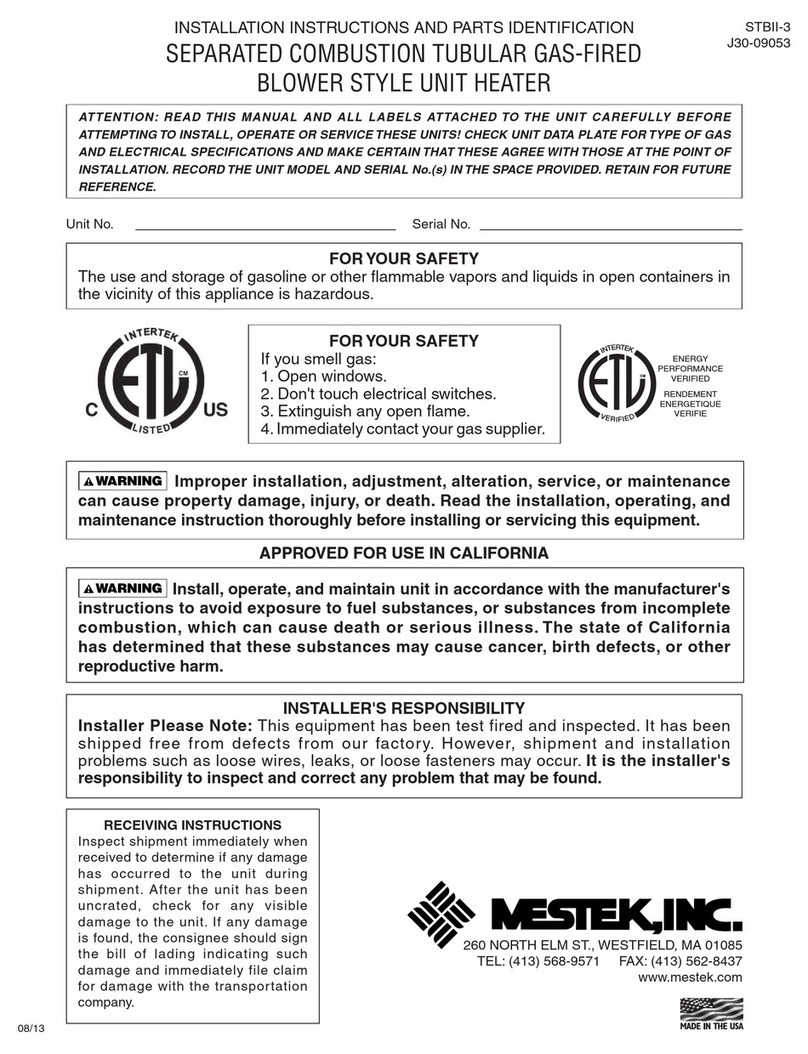
Mestek
Mestek SEPARATED COMBUSTION TUBULAR GAS-FIREDBLOWER STYLE UNIT... User manual
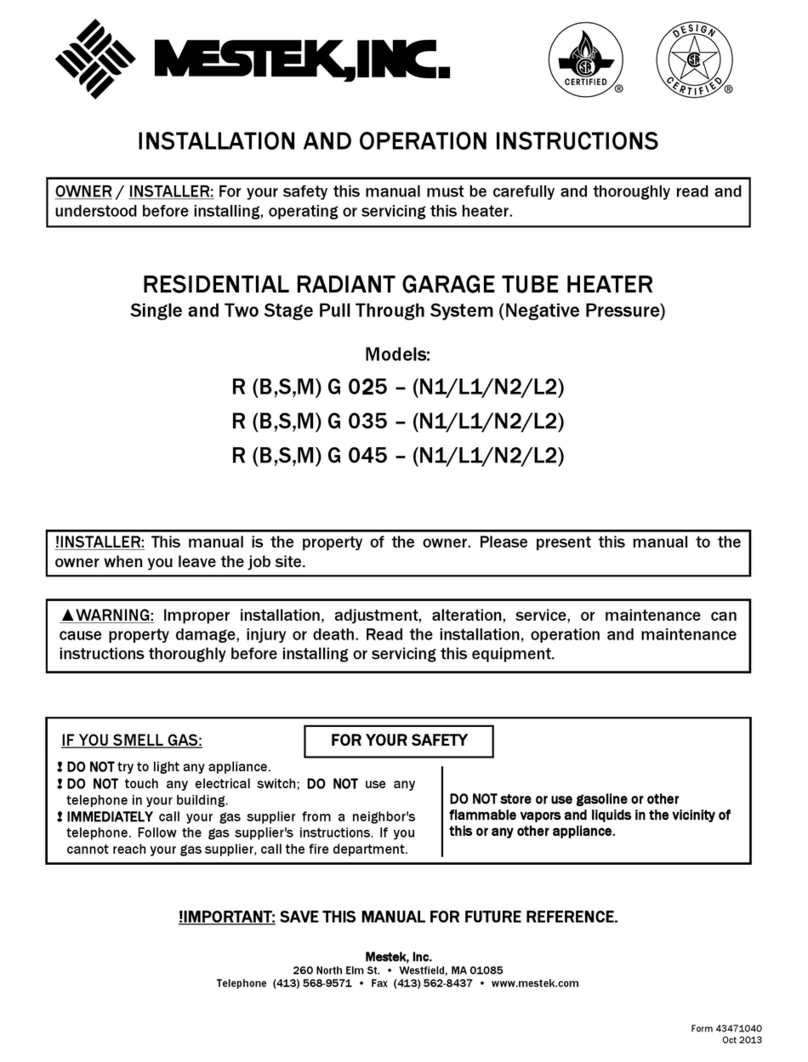
Mestek
Mestek R(B User manual

Mestek
Mestek EMBASSY INDUSTRIES HIDEAVECTOR3 User manual
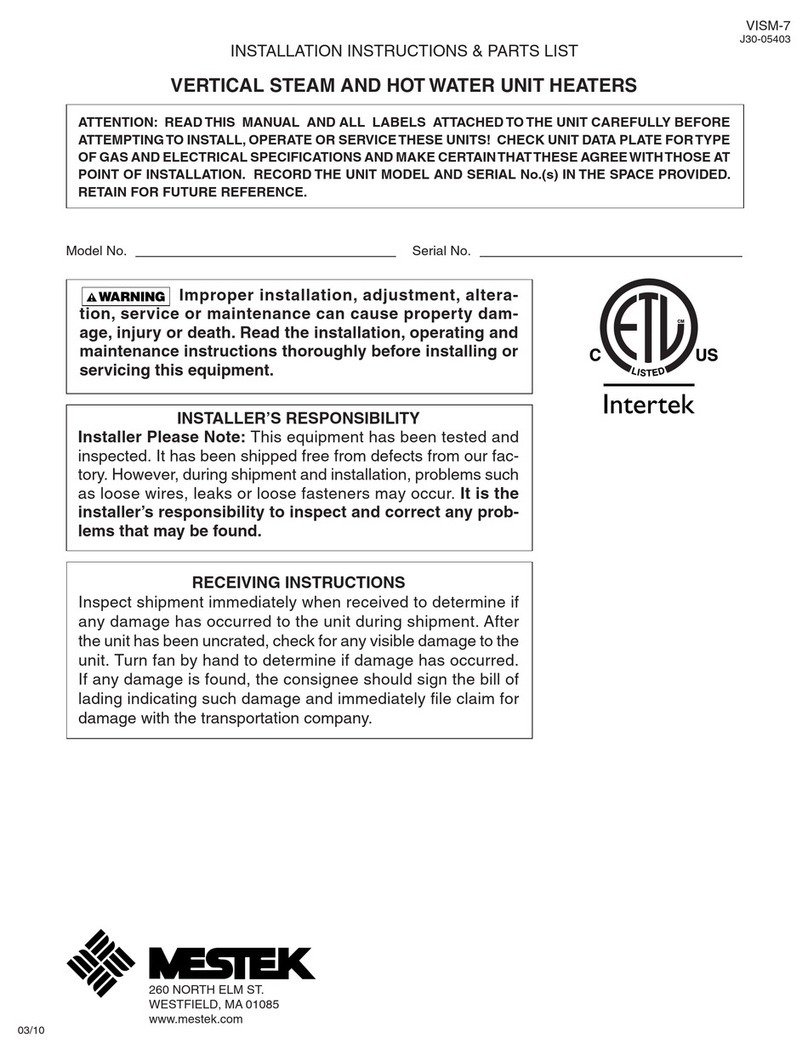
Mestek
Mestek VERTICAL STEAM HOT WATER HEATER User manual

Mestek
Mestek Kickspace Series User manual
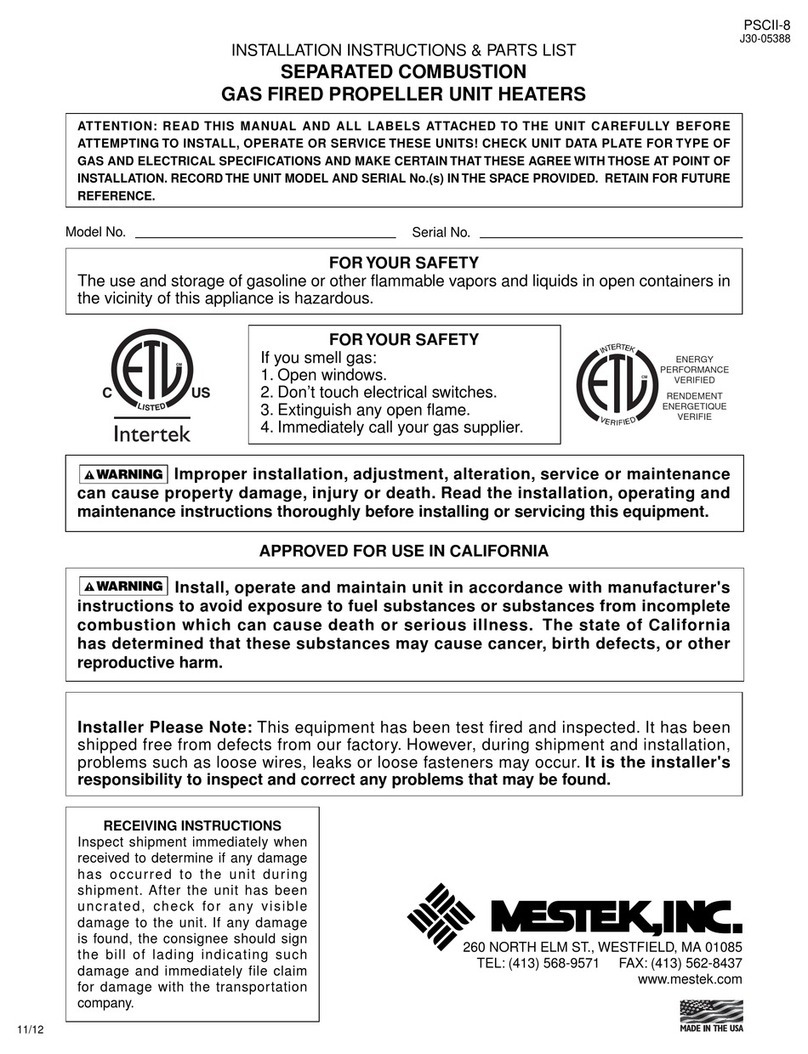
Mestek
Mestek SEPARATED COMBUSTION GAS FIRED PROPELLER UNIT... Datasheet
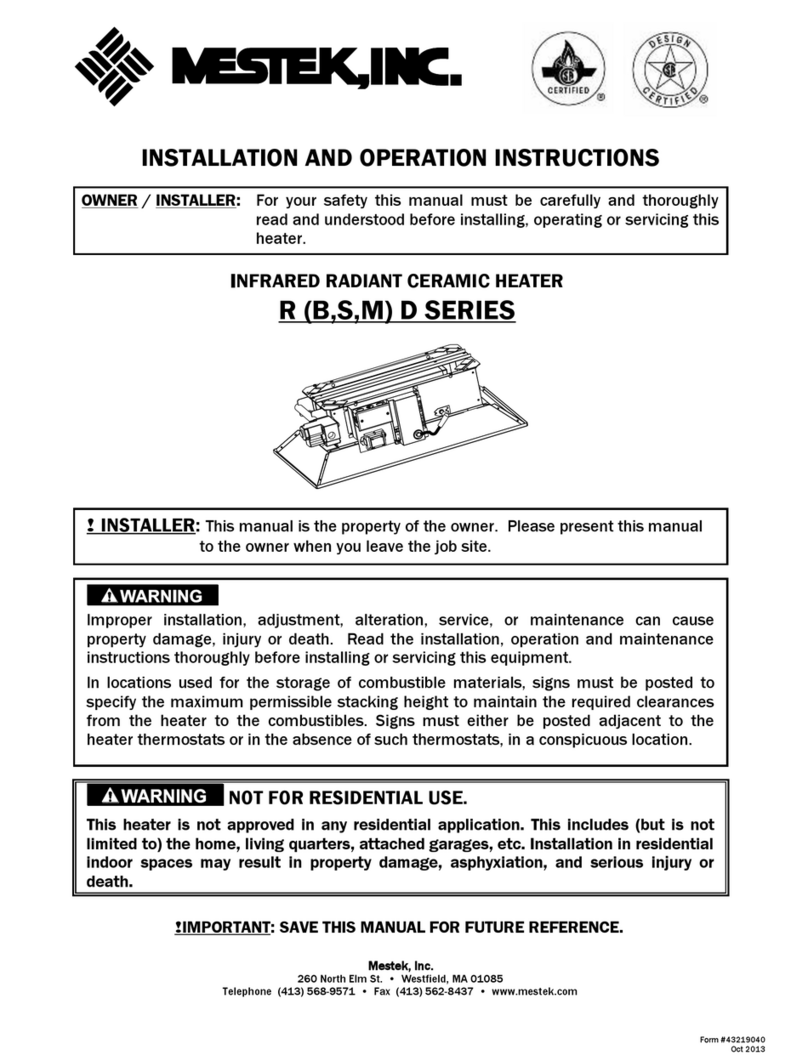
Mestek
Mestek R (B,S,M) D SERIES User manual
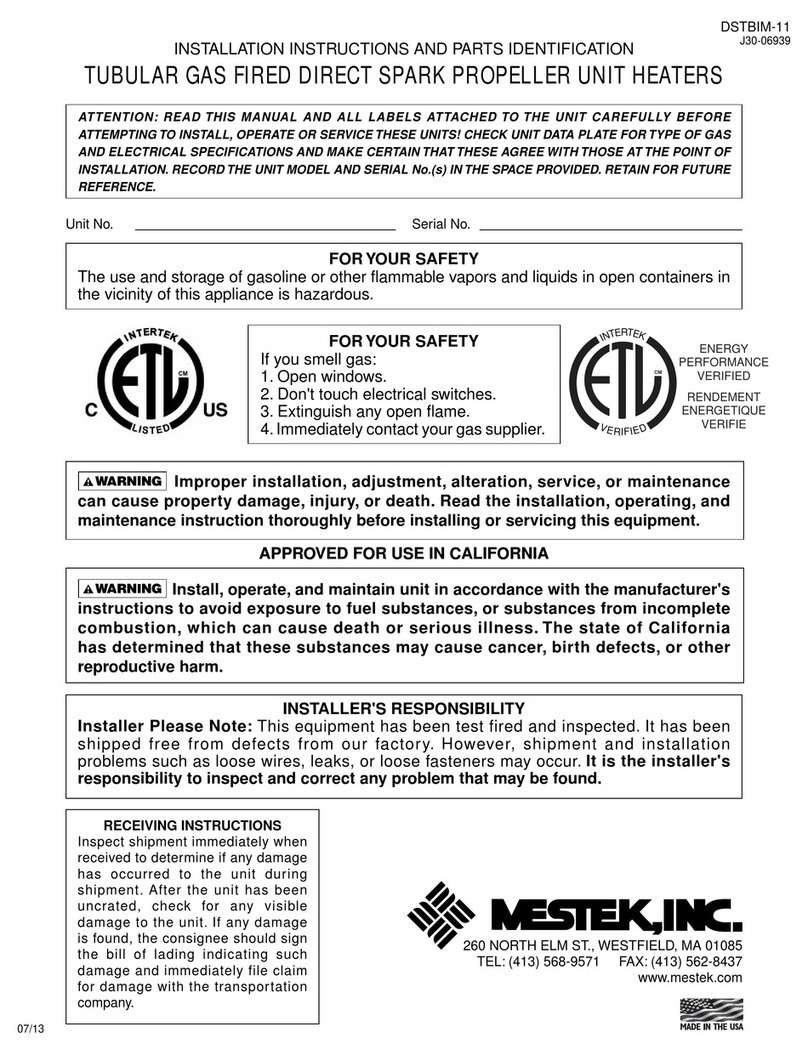
Mestek
Mestek TUBULAR GAS FIRED DIRECT SPARK PROPELLER UNIT... User manual
